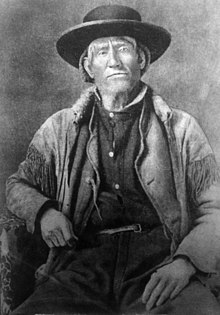
The Bridger Trail, also known as the Bridger Road and Bridger Immigrant Road, was an overland route connecting the Oregon Trail to the gold fields of Montana. Gold was discovered in Virginia City, Montana in 1863, prompting settlers and prospectors to find a trail to travel from central Wyoming to Montana. In 1863, John Bozeman and John Jacobs scouted the Bozeman Trail, which was a direct route to the Montana gold fields through the Powder River Country. At the time the region was controlled by the Sioux, Cheyenne and Arapaho, who stepped up their raids in response to the stream of settlers along the trail.
In 1864 the commandant of Fort Laramie, Colonel William O. Collins, concerned about the hostilities along the Bozeman Trail, asked Jim Bridger to lead a party of settlers from Denver on a new route to the mines through the Big Horn Basin along the western edge of the Big Horn Mountains. In 1859, Bridger had guided a topographical expedition through the area, and knew the region well.[1] The road ran approximately 425 miles (684 km), paralleling the Bozeman Trail and running to the west of the Bighorn Mountains in the lands of the Crow and Shoshone people.[2] In all, 10 wagon trains made the trip in spring and summer of 1864,[1] two of them guided personally by Bridger. The following year, hostilities along the Bozeman Trail had escalated to the point where Major General Grenville M. Dodge ordered Brigadier General Patrick E. Connor to lead the first Powder River Expedition to try to end the raids along the trail. Connor chose Bridger as one of his guides, and Bridger spent the next few years guiding various military excursions into the Powder River Country and never again led settlers along the Bridger Trail.
- ^ a b Wyoming Division of State Parks and Cultural Resources, The Bridger Trail
- ^ Frost, Ned M. (May 18, 1973). "National Register of Historic Places Inventory - Nomination Form: Bridger Immigrant Road - Dry Creek Crossing". National Park Service. with one accompanying photo
